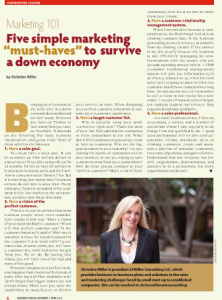Everybody is talking about using Twitter, Facebook, YouTube and other forms of social media to improve business. I’m here to tell you that bringing your business to the next level in this economy does not depend on how many followers you have on Twitter or how many friend requests you receive on Facebook, it depends on the following five simple business MUST HAVES, and guess what, none of them even involve the internet.
1. HAVE a Sales Goal
You must have a sale goal. It can be as simple as, “One million dollars in sales each year.” It could be as specific as, “In 24 months, I’d like to have $3M in Business to Business sales and $2.5M in Consumer sales.” Yes, this sounds basic, maybe even remedial, but it is shocking how many small business owners do not have a sales plan. It is very difficult to get where you want to go without a map. You may end up somewhere decent, but not your ultimate destination. A sales plan is your map. Start simple and build it up. Remember, this is not a test; there is no wrong answer. The number can be changed at any time for any reason, but everybody from the president of the company to the line worker to the sales people need to have at least some direction.
2. HAVE a Vision of The Perfect Customer
This is a crucial MUST HAVE that most business people never even consider. After all, who cares what your customer looks like, as long as they are buying? Let’s restate the MUST HAVE this way; “Have a vision of your most profitable customer.” When will this perfect customer pay? What kind of terms will they have? How much interaction will this customer have with your business? How is their company run? Are they high maintenance? Are they financially stable? How much potential is there for repeat business? Are they fun to work with? I guarantee, at some point, you will have a customer you wish never bought from you, we all do. By having this vision, you will be better prepared for that customer.
When you imagine your perfect client, also imagine their perfect product order. How big is it? How profitable is it? Don’t forget, bigger orders are not always better. I dealt with one customer who was making a product, (we’ll call them “widgets”) out of his basement. These widgets sold well in small mom and pop grocery stores. But when my customer received a small order from a medium sized supermarket chain, he did not have the capabilities to manufacture or deliver the widgets on time. His business no longer exists. He thought his perfect customer was a medium sized supermarket chain, but was it really? When designing your perfect customer, remember to consider your businesses’ capabilities.
3. HAVE a Target Customer List
Write down five businesses or groups you want to have as customers. That’s the start of your list. Who is actually using your product/service right now? Now add similar companies or their competitors to your list. Who are the biggest spenders in your industry? Are you looking for people or companies that are new to your product, or are you trying to take customers away from your competitors? How do these groups compare to your “perfect customer?” It is imperative to make a list of these targets, because then you can focus on how to make them your clients.
4. HAVE Customer Relationship Management system
Do not feel the need to go out to your local office supply store and buy the latest Customer Relationship Management (CRM) software, you just need to have a system. It can be a daily planner or tabbed folders or just a notebook. Of course, you can also purchase some extremely easy and effective CRM software at a relatively low cost, but it is not necessary. When I am asked to increase a company’s sales, the first thing I look at is their existing customer base. Is their business generating as much revenue as possible from their existing clients? If the answer is no, it usually because they are not effectively managing their communications with the people that are already spending money with them. A CRM system will tell you when a contract is up, when the next sales cycle is going to start, when the customer hasn’t been contacted in a long time etc. Do not assume you will remember to call a client in two weeks for a new order. A couple of missed calls or forgotten contacts can lead to lost revenue, and the worst part is, most businesses don’t even know it is happening. If you can’t keep track of the clients you have right now, there really is no point in bringing on new ones.
5. HAVE a Sales Professional
I am not saying this as a contract sales person, I am saying this as someone who has an accountant, a lawyer, a mechanic, a dentist and any other number of specialists that I pay regularly to do things that I am not qualified to do. Business owners usually are extremely passionate and knowledgeable about their product, but this does not mean they are qualified to be a sales professional. A good sales professional will be able cold call potential clients, maximize sales to existing customers, manage relationships, create and maintain a pipeline of potential customers, manage multiple customer contact points, overcome objections and gain referrals. A good sales professional will be able to sit down with a business owner and in one meeting, know answers to all of the above questions and deliver these MUST HAVES. If you can’t afford to hire a full time sales professional, then find one that works on a contract basis. Understand that not everyone has the skill, organization, determination and patience to be a salesperson, but every organization needs one!

 USA
USA